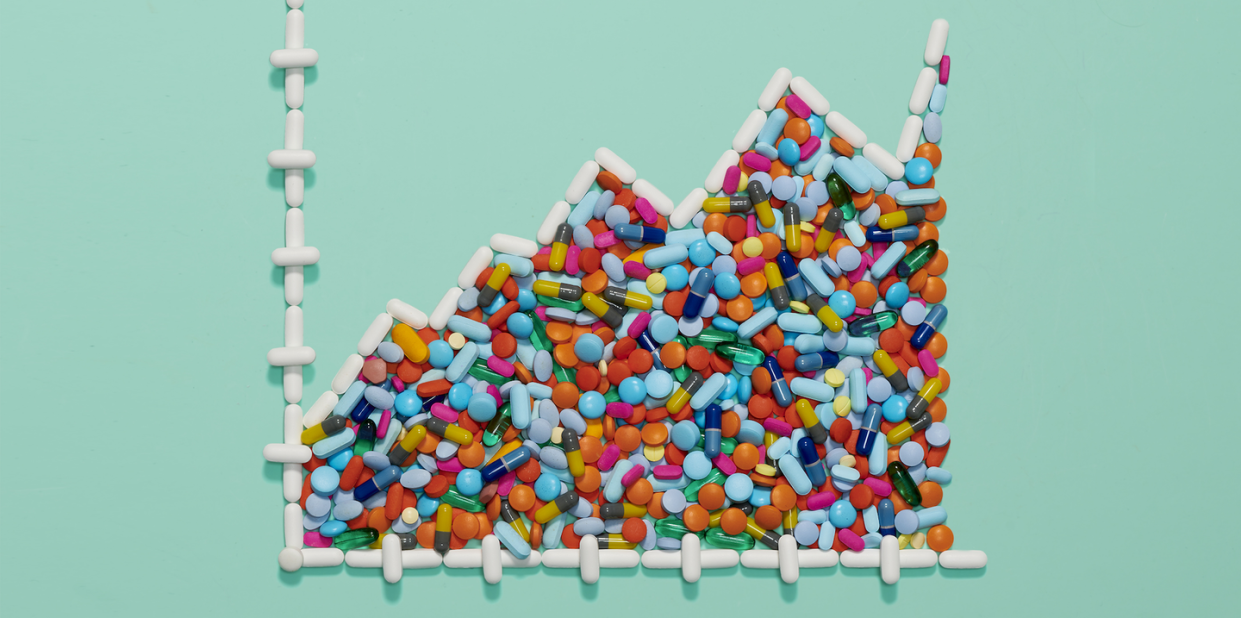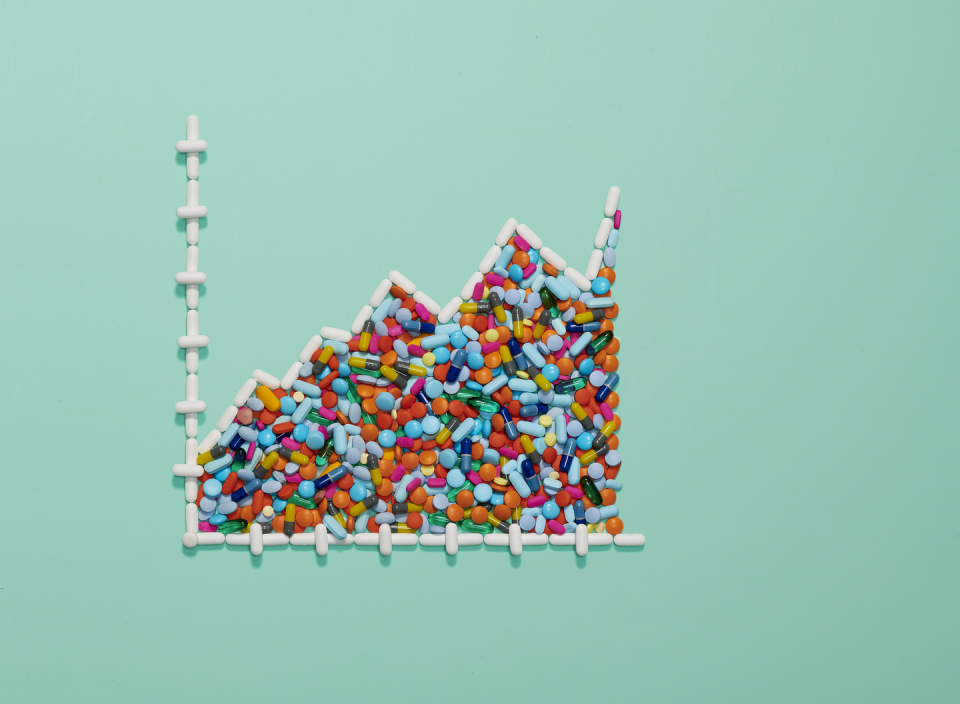CVS Rang Up a Woman's 14-Day Course of Antibiotics for $1,400

If you've ever emptied your wallet to pay for a handful of pills, you know that drug prices in the United States have soared in recent years. Last year consumers shelled out more than $1,000 per person for prescription meds, up from around $400 in 2000, according to Peterson-Kaiser Health System Tracker.
But what’s equally frustrating to patients and health care advocates is that there seems to be no rhyme or reason to who pays what: Depending on diagnosis, age, insurance company, and even which drugstore you happen to walk into, the cost of the same medication can range from a small copay to thousands of dollars.
When the teenage daughter of Pam Singer (note that some names have been changed) had an intestinal illness and needed a 14-day course of antibiotics, the New York City resident was stunned when her local CVS rang up the pills at $1,400. Her insurance deductible had not yet been reached, so Pam was on the hook for the full amount. After researching other options, she discovered she could order the drug online from Canada for about $400 or wait six months for her daughter to turn 18, at which point the drug company would let her use a coupon that would bring the $1,400 price down to—wait for it—$0. “I had to choose whether to spend a chunk of her college savings, import medicine I wasn’t sure was safe or legal, or let my daughter suffer for six months,” Pam recalls. And all this was after having spent a small fortune every month on health insurance premiums.
How Did the Prices Get So High?
The wide discrepancies in drug pricing wouldn’t be quite so shocking if the prices hadn’t risen so quickly in the first place. From 2008 to 2016 the average list price for brand-name oral drugs (ones still protected by patents, meaning that less expensive generics can’t be sold) jumped 9% per year—five times as fast as the rate of inflation—while injectables shot up 15% annually, or eight times as fast as the inflation rate, according to a study in Health Affairs.
Brooke Baker, a 38-year-old registered nurse in Tulsa, came face-to-face with sky-high prices recently when her 13-year-old son, Jackson, who has type 1 diabetes, needed another vial of insulin beyond the two covered each month by insurance. Her bill was a staggering $395 (in Canada, a similar amount of insulin costs just $47; in Australia, $28). Brooke says she knows diabetics who ration their insulin, but this can be deadly. “If it were for me, I might do that. But I can’t compromise when it comes to my son,” she says.
PhRMA, a pharmaceutical industry trade group, points out that in 2018 the net price of drugs (i.e., what the manufacturer earns) rose a mere 0.3%. “But it often doesn’t feel that way for patients” because of high deductibles and coinsurance costs, says Holly Campbell, the group’s spokesperson.
From 2008 to 2016 the average list price for brand-name oral drugs jumped 9% per year—five times as fast as the rate of inflation.
Nonetheless, an examination of 36 top-selling drugs between 2012 and 2018 found that 44% of them more than doubled in price. Some of this is because of loopholes in the patent system, says study author Nathan Wineinger, Ph.D., director of biostatistics at the Scripps Research Translational Institute, a nonprofit lab in La Jolla, CA. When a drug’s patent expires, he says, competitors are supposed to jump in and sell less expensive generics. But manufacturers get around this by making minor tweaks (for instance, changing one ingredient or creating an extended-release variety) that reset the time left on their patents. Drug companies also have been known to pay competitors not to sell generics even after they legally can, a practice known as “pay for delay.”
The drug industry says it is aware of cost issues for consumers: “We are in a new era of medicine where breakthrough science is transforming patient care, but these innovations are meaningless if patients can’t afford them,” says Campbell. “Conversations about costs are important, but we need to have a dialogue that looks at all the players and factors that go into what a patient pays for medicine at the pharmacy counter.”

So What About Insurance?
As Pam discovered, high monthly insurance premiums might not protect against exorbitant prices. More plans are abandoning low drug copays and having the cost of meds go toward a deductible, says Stacie Dusetzina, Ph.D., an associate professor of health policy at Vanderbilt University. “It is a bit of sticker shock if you’ve used the same drug for many years but suddenly, because it’s no longer available with a copay, you have to pay full price,” she says.
Even if you have a low-deductible plan, you may still get stuck. An insurance company can decide that a drug you need is not covered, leaving you on the hook for the full retail price. Melissa Randazzo, 32, had her fallopian tubes removed because of severe endometriosis, and thus she needed in vitro fertilization to conceive. Melissa, a social worker from Staten Island, NY, was fortunate that insurance covered most of the IVF costs, but it would not pay for the vaginal estrogen suppositories crucial to the process, leaving her shelling out $180 for one cycle’s worth of the drug.
There are other insurance quirks: When she was diagnosed with multiple sclerosis nine years ago, Sarah Kirwan, now a 42-year-old disability consultant in Santa Maria, CA, was put on a disease-modifying medicine she needed to inject into her muscles three times a week to keep her condition from worsening. The manufacturer charges a whopping $5,500 a month for the drug; with insurance and other discounts, Sarah pays nearly $800 monthly. Adding financial pain to the physical kind, her insurer lists the drug on a tier that does not let it count toward her annual deductible.
Those high insurance premiums you pay might buy you the privilege of paying more for some meds than you would if you had no insurance at all.
But the most outrageous flaw in the system may be this: Those high insurance premiums you pay might buy you the privilege of paying more for some meds than you would if you had no insurance at all. Say your insurer offers you a $30 copay, but the price for the same drug without insurance would be only $10—for years, a law prevented pharmacists from pointing this out. Fortunately, thanks to 2018 legislation, yours can now give you a heads-up when bypassing insurance would save you money. “Your pharmacist can be a good resource for all sorts of pricing information,” also alerting you if a generic or a related drug might be cheaper, says John Rother, president and CEO of the National Coalition on Healthcare, an advocacy group for lowering prices based in Washington, DC.
And Then There Are the Middlemen
Unlike in countries such as Canada and Denmark, which have single-payer systems in which the government is responsible for purchasing and pricing drugs and so has a lot of bargaining power, in the U.S. each insurance company and large employer makes its own deals with pharma companies. That’s a lot of work, which is where pharmacy benefits managers (PBMs) come in. They’re hired to negotiate for better prices—though not necessarily better for you. PBMs initially came into being to bring down costs; the idea was that they’d have more negotiating clout than individual companies, Dusetzina explains. But there is a lack of transparency: No one knows what rebates PBMs get from drug companies and whether they pass the savings on to consumers.
Let’s say a PBM gets a high-priced drug at a good discount, prompting the insurer to list this as its preferred drug (meaning that’s the one it will cover). You may be stuck buying a more costly product than you’d have to if a cheaper drug were allowed in your plan. Deals are also bundled, so the PBM may get a better price for another drug while agreeing to pay more for the one you need. Since this all happens behind closed doors, the public has no idea who is profiting most. And because each plan has a different arrangement (and every insurance company has many plans), even your doctor has no way of knowing what a drug might cost you, Dusetzina says.
The drugstore where you shop also comes into play. You’d think that after all these negotiations, the price would be the same whether you popped into a store near your house or one close to your office. Paul Hauptman, M.D., now dean of the graduate school of medicine at the University of Tennessee-Knoxville, and his then-colleagues at the Saint Louis University School of Medicine called 175 Midwest pharmacies asking for prices on three heart medicines. They found that the pills varied from $12 to almost $400 for a month’s supply. It was hard to identify a consistently inexpensive store, because in some cases one pill was cheap but the other two weren’t. There was no logic to the pricing, Dr. Hauptman says—it wasn’t consistent by location, by national chain vs. mom-and-pop, or in one case even between stores in the same chain.
It can be tempting to storm out of the pharmacy empty-handed, but this is risky, as Shari Adams, from Raleigh, NC, learned. Several years ago, her doctor diagnosed her with ulcerative proctitis, tiny ulcers in her large intestine, and prescribed a rectal suppository. When Shari learned that her cost would be $500, she decided not to pick up the meds. Her symptoms eventually worsened to the more serious ulcerative colitis.
A true fix will have to come from the government—some combination of forcing companies and PBMs to be more transparent, clamping down on bad pharma practices, and allowing foreign imports, though some believe a single-payer system is also needed. While politicians on both sides of the aisle have proposed plans, it may be years before there’s any agreement on how to move forward.

How to Save Money on Prescription Drugs
When only one med is approved for your condition, all you can do is shop around for the lowest price. But sometimes you can get a better deal.
• Ask if there’s an alternative. Doctors often have no idea how much a drug they’ve prescribed will cost you. “If you discover that a product is expensive, call and ask your doctor if something cheaper might also work,” advises Inmaculada Hernandez, Ph.D., Pharm.D., an assistant professor of pharmacy and therapeutics at the University of Pittsburgh School of Pharmacy. There may be an older pill with generic competition that does the trick.
• Look for coupons. One way to save is through drug-manufacturer coupons, but experts caution that this is a short-term solution. You can also visit Medicine Assistance Tool, launched by PhRMA (mat.org), to see if there is a manufacturer-supported assistance program for which you qualify.
• Score lots of samples. Drug companies woo doctors by giving them samples for patients—ask if you can have more. When one woman’s daughter was prescribed a pricey headache remedy, her doctor loaded up a bag full of samples, saving her thousands.
• Find the best local price. There are sites that can help: Rx Savings Solutions (available through certain health plans) not only finds the cheapest option in your area, but will sometimes ask your doctor to tweak your prescription if, say, capsules cost less than the prescribed tablets. GoodRx compares prices at neighborhood pharmacies and sends coupons to your smartphone. (Note that because you’re not going through insurance, drugs you buy this way typically don’t count toward your deductible.)
• Shop online. Online pharmacies have popped up to sell drugs outside of insurance plans. To avoid scam sites, check with the website safe.pharmacy, a verification program set up by the organization that licenses pharmacists. Two reputable sites are HealthWarehouse and Honeybee Health (for generics).
• Consider Canada. Brand-name drugs are sold more cheaply in foreign countries, though the FDA cautions Americans against buying foreign drugs because they “may not be safe or effective.” But Rother says that buying drugs from a developed country is likely fine. Meds from Canada, Europe, and Mexico have had few quality problems, he notes, and many are made in the same overseas plants as American pharmaceuticals.
• Most important, lobby your congressperson. Systemic changes to bring down exorbitant prices require federal laws ensuring better competition, transparency, and value-based pricing, Rother says. Angry about high prices or a fan of single-payer health care? Make your voice heard.
This story originally appeared in the January 2020 issue of Prevention.
Like what you just read? You’ll love our magazine! Go here to subscribe. Don’t miss a thing by downloading Apple News here and following Prevention. Oh, and we’re on Instagram too.
You Might Also Like

